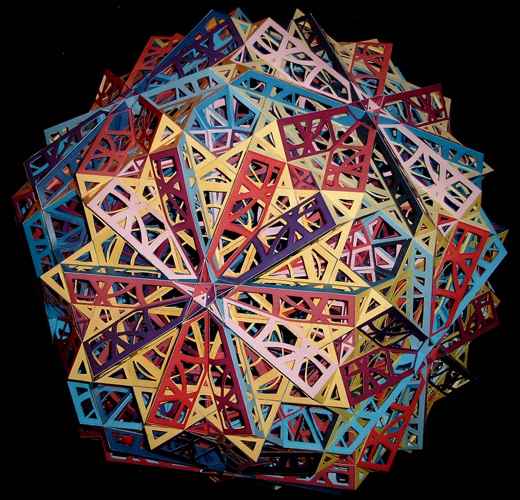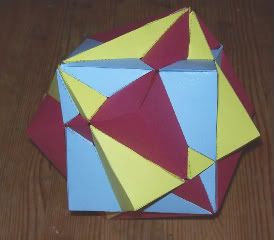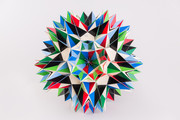Page 2 of 3
Posted: Thu Feb 28, 2008 2:05 pm
by robertw
starbase1 wrote:Given the many, many polyhedra available, can anyone recommend an interesting one with lots of hollow spaces? (And tell me where to locate it in the menus!)
The Stewart Toroids are a good place to start. Select "Stewart Toroids" from the category drop-down list in the toolbar (initially showing "Platonic"). Then just step through them with the Right arrow key. OK, so they start off not too exciting, but keep going. For ones with lots of holes, try:
Octagon-Drilled Truncated Cuboctahedron
Drilled Truncated Dodecahedron
Rotunda-Drilled Truncated Icosidodecahedron
Cupola-Drilled Truncated Icosidodecahedron
(Select those from the model drop-down next to the category drop-down).
For even more (and some more complex ones), select "Stella Library" from the category list, then "<More Stewart Toroids>" from the model list, and step through them again with the Right arrow.
Rob.
Posted: Thu Feb 28, 2008 3:10 pm
by starbase1
Thanks Robert, I'll give that a go as soon as I can!
Posted: Sat Mar 01, 2008 11:26 am
by starbase1
Ulrich wrote:Up to now, the greatest polyhedral challenge to me was W 108, the Great Truncated Icosidodecahedron.

This model has a diameter of about 40 cm. I never counted the number of facelets, but I know that I needed 153 sheets of paper for it. I used 14 colours. For more pictures and a little video clip see:
http://www.polyedergarten.de/e_w108.htm
Ulrich
Is this object available in Stella?
Nick
Posted: Sun Mar 02, 2008 9:07 am
by Ulrich
starbase1 wrote:Is this object available in Stella?
Yes, it's a uniform polyhedron. You just click on the two blue drawers and enter its Wenninger-No "W108" to choose it.
u.
Posted: Sun Mar 02, 2008 9:47 am
by starbase1
Thanks, found it.
But why does yours have so many homes compared with the Stella one? Sorry if that's a dumb question...
Posted: Sun Mar 02, 2008 2:10 pm
by robertw
starbase1 wrote:why does yours have so many homes compared with the Stella one?
I think you mean "holes"

This is Ulrich's style, to leave holes in the faces so that the inner parts can also be seen (the parts of faces normally hidden within the model). I believe Ulrich uses Stella's stellation features to create the nets for the inner parts of faces. Of course, the decision as to where to put the holes are entirely his

Rob.
Posted: Sun Mar 02, 2008 6:56 pm
by Ulrich
robertw wrote:starbase1 wrote:why does yours have so many holes compared with the Stella one?
This is Ulrich's style, to leave holes in the faces so that the inner parts can also be seen (the parts of faces normally hidden within the model).
That's right.
robertw wrote:I believe Ulrich uses Stella's stellation features to create the nets for the inner parts of faces.
That's right too. Stella gives me the shape with its inner parts and the stellation diagram, which I need to design my nets. Unfortunately stella does not allow the user to export the diagram in a vector format, which could be very useful for me.
Ulrich
Posted: Sun Mar 02, 2008 9:45 pm
by starbase1
Ulrich wrote:
That's right too. Stella gives me the shape with its inner parts and the stellation diagram, which I need to design my nets. Unfortunately stella does not allow the user to export the diagram in a vector format, which could be very useful for me.
Ulrich
Have you tried software to convert from bitmap to vector? With such clean simple shapes I would expect it to work really well. I've not tried it myself in a very long time, but I seem to remember that Corel Draw used to have that feature...
Nick
Posted: Mon Mar 03, 2008 7:10 am
by Ulrich
starbase1 wrote:
Have you tried software to convert from bitmap to vector?
Yes, I tried it and the results are not good at all. But there's a trick I was told by Rob Pierce: You can print the net in the pdf-format and import that file in corel. This is much better, but not the way it could be because if the net is complex, there are lots of unused elements which have to be eliminated by hand.
Ulrich
Posted: Mon Sep 08, 2008 6:05 pm
by Nordehylop
Marcelteun, have you ever considered building the "inverse" of your fractal octahedron? It would be basically the same shape but with tetrahedral cells and with octahedral shaped spaces between the cells.
A similar idea would be the three dimensional Sierpinski gasket, but that would have the tetrahedra joined by their corners instead of their edges.
Posted: Mon Oct 20, 2008 12:13 am
by Brendan
The most complex one I've made so far is just the great icosahedron.

I made my initial models, the Platonic, Archimedican and Kepler-Poinsot solids before I got Stella4D. Those got lost and damaged.

Now I live in a nice place with a big bookcase, so I could make more once I get a printer.
Sure the suggestion above of making the inverse of the fractal octahedron could be interesting. Octahedra and tetrahedra tile flat 3D space.
Posted: Sun Apr 25, 2010 8:51 pm
by Gronkling
A 3-fold dihedral variation of the compound of 3 cubes. Only 108 facelets but it gets quite hard near the end. Heres a picture:

Re: What's the most complex model you've ever made?
Posted: Mon Sep 23, 2019 10:01 am
by marcelteun
The model with the most amount of pieces to glue has changed for me (finished last year in Februari). Now it is the Great Diretrosnub Icosidodecahedron consisting of 2580 facelets

I have a page with some more pictures and an interactive model here:
http://tunnissen.eu/polyh/uniform_compo ... issid.html
Currently I am building another model that doesn't consist of so many parts (just 120 parts), but I did fail building a model of it in 2014. This time I am quite sure I should be able to finish it. It will try to keep you informed
Re: What's the most complex model you've ever made?
Posted: Tue Sep 24, 2019 12:07 pm
by robertw
Fantastic model Marcel!
Re: What's the most complex model you've ever made?
Posted: Tue Sep 24, 2019 1:11 pm
by marcelteun
Thanks, Robert


